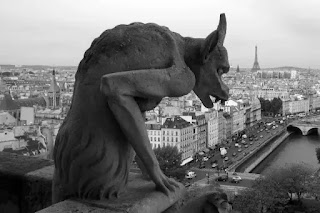High above Paris, the figures along Notre-Dame lean forward with the patience of creatures who have never blinked. Their stone bodies curve and crouch, talons gripping ledges, mouths frozen open as if caught mid-thought. They look less like ornaments than like memories given posture. Born from the need to spit rain away from sacred walls, they grew teeth and expressions, their utility thickening into symbol. The building found a throat, and the throat learned to speak. What began as drainage became warning, confession, a carved admission that monstrosity lives close to prayer. Their shapes hold theology without words: backs arched in strain, jaws slack with judgment, embodying what the cathedral absorbs rather than repels.
Most of these watchers arrived late, summoned by longing rather than faith. When revolution stripped the cathedral bare, imagination rebuilt it. Stone answered story, and an architect carved dreams where gaps had been. These chimères vomit water; exhale thought. One broods with chin in hand, wings sagging, eyes dulled by having seen too much of the same human drama repeat below. City and statues mirror each other, layered with damage and beauty, endurance and fatigue. Fire licked the roof and passed; the watchers remained, blackened but calm. They feel like the cathedral’s subconscious hardened into form, its loves and dreads made visible. They diagnose rather than decorate, asking nothing, judging nothing, already older than fear, already past the need for answers.




No comments:
Post a Comment